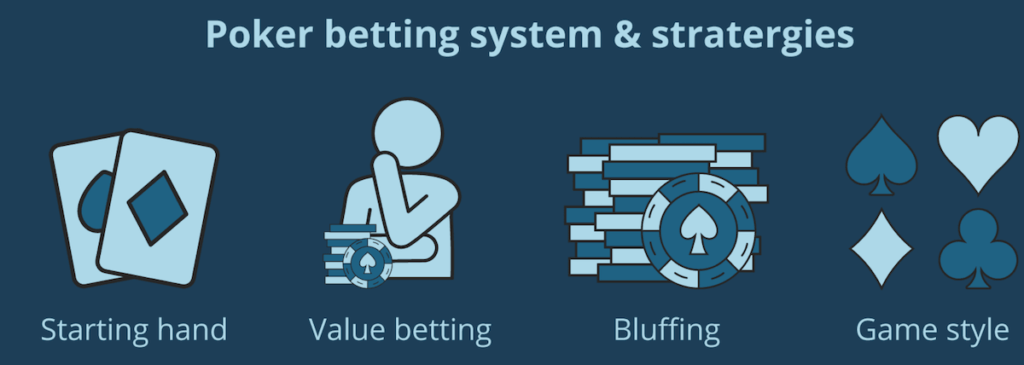Why Use a Poker Strategy?
Any skill-based casino game will benefit from a strategy. Online poker winning strategies aim to increase the odds in your favor while disrupting your opponent’s play. Combining these two components may increase your chances of winning, especially when you’re a professional player. It also teaches you how to adapt your game to any situation.

Do poker strategies guarantee a victory?
As previously mentioned, learning a strategy is the key to how to win at poker. However, using a poker strategy doesn’t guarantee a win or result in massive payouts. Strategies were conceived to help players be more consistent with their hands, allowing them to exploit other players better.
It can also help to reduce the house edge (typically around 2%, depending on the poker variation), as you’ll learn to make informed betting decisions.
While strategies don’t guarantee a win, they’ll help you in many other ways. The most complex poker betting strategies allow you to exploit flaws in your opponent’s games and see right through their hand, potentially shifting the odds to your side.
It also offers many psychological insights that improve how you read other players. Not to mention that poker betting strategies can have real-world applications, like improving your negotiation and decision-making skills.
Choose a Playing Style Before You Pick a Strategy
Before you start looking into the various strategies available, it’s essential to select your playing style. Many consider an aggressive style the best, although the top players mix elements from the four main playing styles. Here are the best poker tips for beginners regarding playing styles:
Tight
A tight playing style is usually preferred by beginners, allowing them to analyze the game slowly. It involves playing with few yet strong hands. It requires more patience as players must wait for a more substantial hand before proceeding.
Loose
A loose playing style involves playing a fair number of hands. Open players often enter the pot with various indicators, from strong to weak. Understanding the game’s inner workings is crucial before attempting to play with an open playing style.
Aggressive
More experienced players often use an aggressive playing style. It can provide excellent results in the right circumstances. It involves betting high or raising whenever possible. As with other playing styles, it also requires a lot of skill.
Passive
Beginners typically use passive playing styles. It involves playing slowly, checking, and calling bets while avoiding raising.
Basic Poker Strategy

The basic poker strategy isn’t a strategy per se. This term refers to tips designed to improve your poker betting strategies and skills. The basic poker strategy includes three key aspects—raising, calling, and knowing the pot odds. See how learning about these improves your game:
- Raising – Learning about the correct times to grow to understand the fundamentals of basic poker strategy is crucial.
- Calling – Calling is as vital as raising. Experienced players will know exactly when to call.
- Pot odds – This term helps you understand if a hand is worth playing. Players should constantly be aware of the pot odds.
When should you raise?
Generally, players raise their hands when they think they have a strong chance of winning. But players should also increase if they’re looking to steal blinds or throw their opponents off after the flop.
Raising disrupts other players by forcing them into the game or leading them to fold. Here’s an example of a raise:
Hand example
- $50/$100 full-ring game.
- You’re playing from a late position.
- Your hand is A♦K♦.
- The flop is 2♦8♠Q♣.
In this situation, you should raise after the flop.
When should you call?
The rules that apply to raises can also be used in calls. Players should call when they’re confident they have a good hand. However, it’s also wise to contact them if you have a hand you think is worth risking. If a writing isn’t good enough to raise, it’s not good enough to call.
Hand example
- $50/$100 full-ring game.
- You’re playing from a late position.
- Your hand is A♦A♣.
- The flop is 10♦7♠2♠.
In this situation, you should call.
Pot odds
Many experienced players will tell you that pot odds are one of the essential aspects of online poker winning strategies, and they’re right. Being aware of the pot odds is crucial to improving your game.
Looking into it allows you to calculate your probability of winning or losing. To calculate the pot odds, you must compare the current pot size to the bets. For instance:
Let’s say you place a $100 bet on a $500 pot, increasing the total to $600. Then, you divide the pot by the bet – 600:100. From here, you divide to the smallest common denominator, which is 6:1.
Then, convert this ratio into a percentage of 85.71% to 14.28%. This means you’re 14.28% likely to have the best hand, assuming your opponents bet half the pot.
The Best Poker Winning Strategies
Game theory optimal (GTO) and exploitative are the two best poker strategies for professional players. They’re highly complex tactics designed to render you unexploitable or help you exploit other players. Check out their differences and which one to use below:
GTO vs. Exploitative Strategy
GTO is essentially a flawless strategy that most poker professionals use. Its goal is to defend players from their opponents, making them unexploitable. Since you’ll always be making the perfect decisions, using GTO can increase your winning rate.
On the other hand, exploitative strategies add several elements to the GTO strategy, which helps players exploit their opponents, maximizing profits. It involves many complex mechanics to read your opponents’ hands and tells.
Take a look at how each strategy works in the table below:
| GTO strategy | Exploitative strategy |
|---|---|
| A defensive strategy designed to increase your chances of winning and used to protect players from exploitation by their opponents. It relies on your strengths to defend your stack. | A GTO-based poker strategy with exploitative elements. They are designed to exploit other players and maximize profits. Uses your opponent’s weaknesses against them. |
What Poker Strategy to Choose?
Several factors influence your choice of poker strategy, most notably your playing style, skill level, and poker variant. For instance, beginners usually benefit from a basic strategy and an aggressive playing style, while pros and tournament players are better off using a GTO or exploitative method.
| Best strategies for a beginner | Best strategies for a pro | Best Poker tournament strategies |
|---|---|---|
| Basic poker strategy – Learning when to call, raise, and know the pot odds. | GTO – The perfect strategy designed to make you unexploitable. | GTO – A defensive strategy so you can last on the table for longer. |
| Aggressive playing style – Puts you in control of the pot | Exploitative – Adds exploitation elements to GTO so you can maximize profits | Exploitative – Used to knock out your opponents in the late stages. |
Poker strategies for beginners
Here are the best poker tips for beginners regarding strategies:
- Basic poker strategy – Knowing when to call or raise puts you in a better position than most beginners. You should also frequently calculate the pot odds to determine your chances of winning.
- Aggressive playing style – Most beginners don’t know how to respond to a bold playing style. Use it to steal blinds or force other players into folding.
Poker strategies for professionals
Professionals should focus on the psychological side of poker and learn about GTO and exploitative strategies:
- GTO – Players aware of this strategy will make perfect calls and increase their chances of winning.
- Exploitative – This strategy is better for players looking to play aggressively and increase their profits by directly attacking other players.
Poker strategies for tournaments
Most tournament players will start using a GTO-based approach and finish with an exploitative strategy, here’s why:
- GTO – As a defensive strategy, using GTO in the early stages is crucial to making you last longer on the table and make your stack grow larger.
- Exploitative – During the final stages, it’s best to start exploiting your opponents to force them into giving up.
Should You Go With a Short or Long-Term Strategy?
Choosing to think short or long-term will depend on your goals as a player. If you’re in a tournament, it’s essential to think long term, focusing on keeping a sizable stack and not betting too hard.
You can think for small stakes or when playing with beginners in the short term. Make big bets and force your opponents into folding. Play with their emotions and let them make mistakes. Nonetheless, thinking long-term is always favorable.
Avoid These Beginner Mistakes
- I was not knowing poker terms.
Not knowing the primary poker language affects your knowledge of the game. We recommend taking a look at our glossary.
- I am using inadequate strategies.
Strategies are directly related to your playing style and skill level. Consider reading our guide and choosing the best method for your situation.
- We are applying poker strategies to other games.
Applying poker strategies to video poker games, for example, is often futile. Video poker strategies typically include choosing a game with a good RTP and using bonuses to your advantage.
- Lack of confidence.
Most beginners will frequently fold due to a lack of confidence. We recommend opting for a tight and aggressive playing style.
- You are bluffing too much.
Bluffing is meant to be unpredictable. Consider bluffing less often to increase your chances of success.
